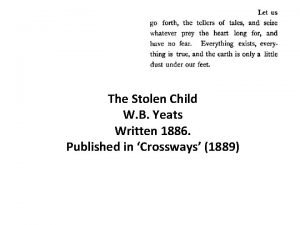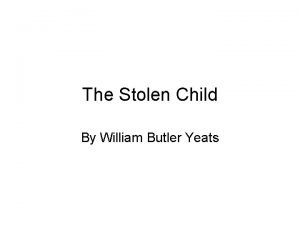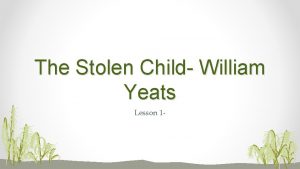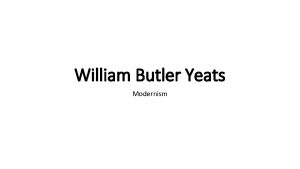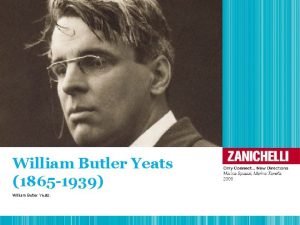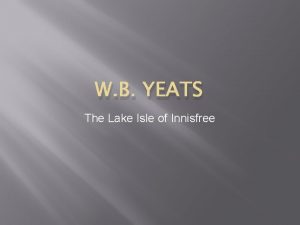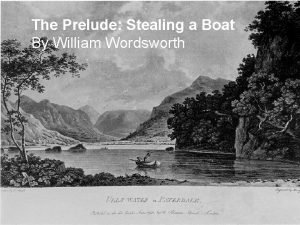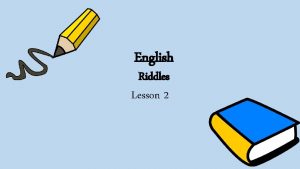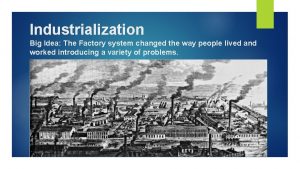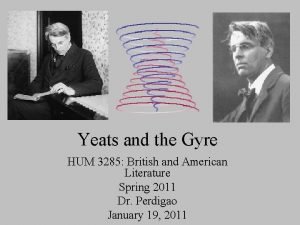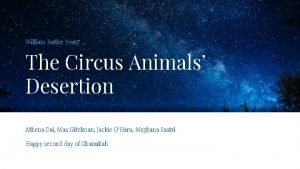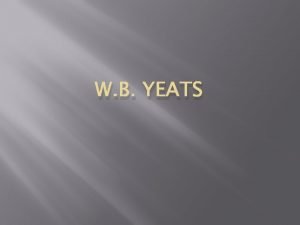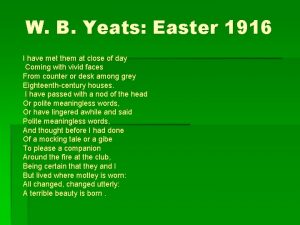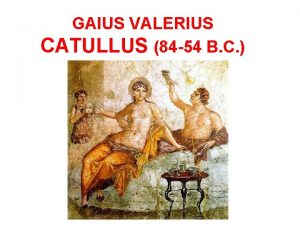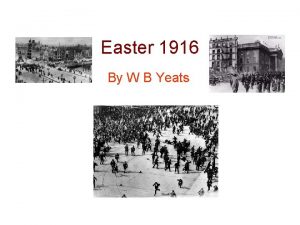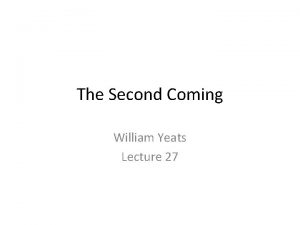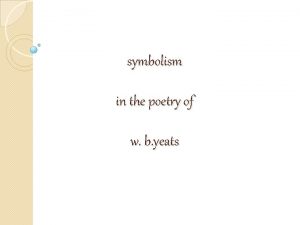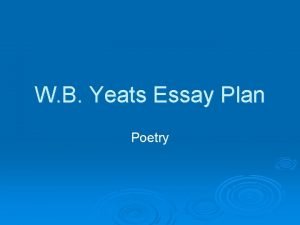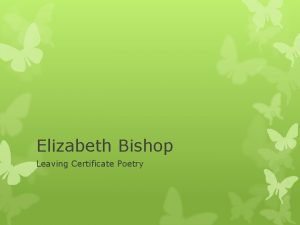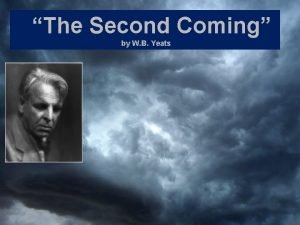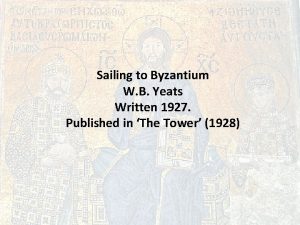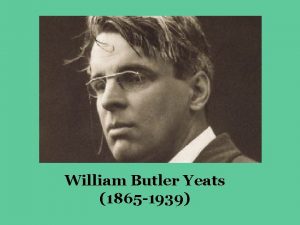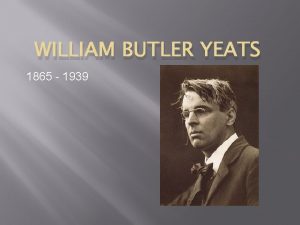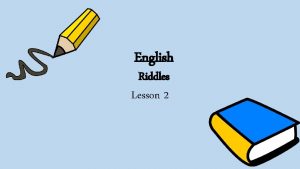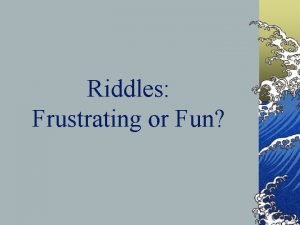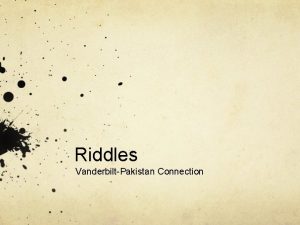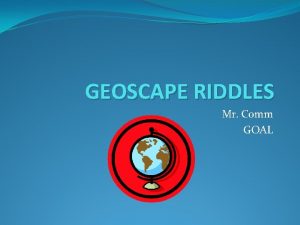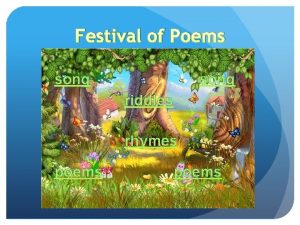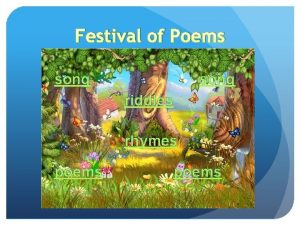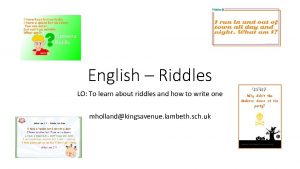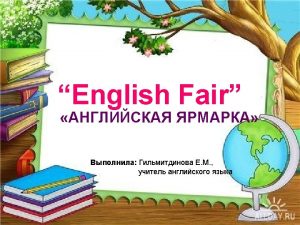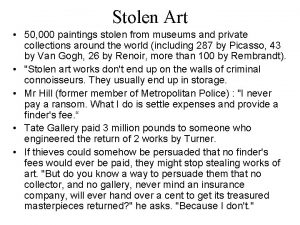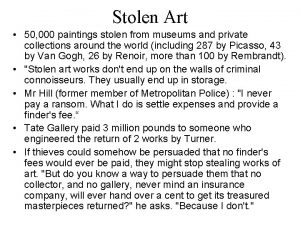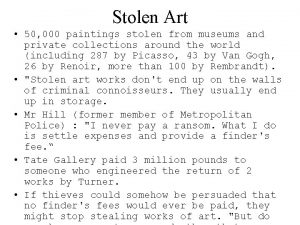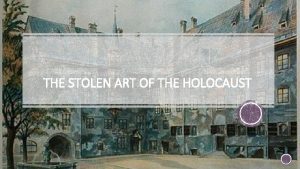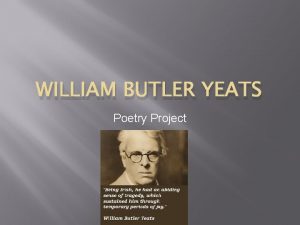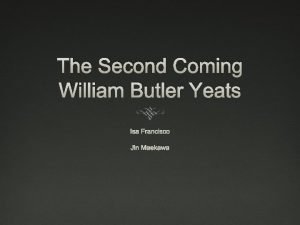The Stolen Child William Yeats Lesson 1 Riddles


























- Slides: 26

The Stolen Child- William Yeats Lesson 1 -

Riddles • I’m often running yet I have no legs. You need me but I don’t need you. What am I? • A man was taking a walk and it started to rain. He did not bring an umbrella or wear a hat. All of his clothes got wet but not a single hair got wet. How is this possible? • What has keys but no locks, Space but no room, You can enter but you can’t exit.

Starter: Visual Literacy Write 2 -3 sentences to describe what you think is happening in each picture

Objectives • Procedural: Annotate and analyze themes, poetic devices and meaning in The Stolen Child • Declarative: I can understand identify the context of a poem, its meaning and literary devices

William Yeats • William Butler Yeats was an Irish poet and one of the foremost figures of 20 th-century literature. • William Yeats’s early poems were Odes to the beauty and mystery of the Irish countryside • William Yeats poems are known for their ‘lyrical’, ‘musical’ and ‘mythological’ qualities • His poem, “The Stolen Child” is a poem about the Irish mythology of fairies who steal children away from their families and homes

Summary of the poem • Context: o The poem was written in 1896 and first published in the Irish Monthly in 1889 • Meaning/cultural significance: o o In Irish culture and folklore, fairies were considered to be somewhat ‘evil’ creatures. • Summary: o The poem “Stolen Child” is about a young boy who led away by the temptation of the fairies. o Land of the fairies represents an ‘escape’ from the human world of suffering

Setting • Setting: Poem is set in the beautiful, bright landscape of Co Sligo highlands. Poem’s setting reflects the element of LIGHT- beauty, innocence, purity)

What words come to your mind when you see these pictures? Describe the words/images that come to your mind


Summary of the poem Key Themes: Light: • • • The setting reflects purity and beauty The child in the poem represents light through his childhood: Naivety, curiosity and wonder of the world Dark: • • The ‘human world’ represents the darkness in the poem. The darkness refers to the sorrow in the human world; Yeats could be referring to the war in which many Irish people lost their identity and lives. The fairies can reflect either Light or Dark (depending on how you interpret the poem). • Light as they can be interpreted as trying to help the boy by taking him away from the ‘sorrowful’ world. • Dark as they have no right to encourage the child to leave behind his home, parents and his world

How does this reflect reality? : • Consider how the poem reflects the human desire to ‘escape’ the painful realities that we sometimes live in. How many of you consider ‘running away’ or escaping your troubles? • The Stolen Child reflects our human desire to enter a ‘fantasy world’ to escape our fears

What ‘reality’ do you think the poem could be talking about? War Grief Death Human Suffering Depression

Vocabulary Dictionary Word Meaning Sleuth Wood Forest/Woodland located in Sligo, Ireland Herons Birds with long necks, legs and bills, living along riverbanks and marshes Faery (Fairy) A fairy is a type of mythical being or legendary creature in European folklore Vats A large tank or tub Glosses Shines Rosses Marshes (Swamp) Glen Car Area of wild mountain scenery Slumbering Sleeping Solemn Sad, Serious Hob Shelf on a fireplace used to keep things warm

Listening to a reading of the poem • Highlight the words from the vocabulary dictionary as you hear them being read in the poem • https: //www. youtube. com/watch? v=g 9 hn. UYV 06 t 4

Brain Break: 5 minutes • https: //www. youtube. com/watch? v=Nv 5 Nh. PDUt. XY&t=0 s&index=188&list= PLVNocu 2 A 1 SABPv 0 mzr. HVz. Hk 0 L 8 I-A 6 s-N

Activity: Examining the moral in the story The story is about the boy being led away from the human world to the ‘tempting’ world of the fairies. Completing this activity will help you understand the moral themes in the text. The Child The Fairies • Why do you think the child believes the fairies? • Why is it selfish of the fairies to take the boy away? • Is it possible the child is suffering from • Why do you think the fairies are some kind of hardship? making all these promises to the child? • Do you think the child is mature enough to understand the consequences of what he is doing? • Do you think ‘fairy land’ is actually better than the human world? • Is it ever okay to take a child away • Have the fairies taken advantage of the from it’s parents? child’s age?

Summary Reflection: • What is good and evil about the intentions of the fairies in this poem? • Explain how William Yeats warns us about the temptation to ‘escape’ to a fantasy world. What is the moral of the poem?


Lesson 2 - Annotation of the Poem

Start Annotating the Poem Setting: Where dips the rocky highland Imagery: Of Sleuth Wood in the lake, There lies a leafy island Rhyme: Where flapping herons wake Themes: Light has been represented by positive The drowsy water-rats; imagery; Light, Goodness, Harmony/Peace There we’ve hid our faery vats, Atmosphere: Full of light and goodness, Full of berries (‘heaven’ or the ‘Garden of Eden’) And of reddest stolen cherries. Come away, O human child! What is happening: To the waters and the wild • Describing their magical land full of animals, With a faery, hand in hand, beautiful fruits (berries). For the world’s more full of weeping • Fairies are encouraging the human child to come away than you can understand.

Where the wave of moonlight glosses The dim grey sands with light, Far off by furthest Rosses We foot it all the night, Weaving olden dances, Mingling hands and mingling glances Till the moon has taken flight; To and fro we leap And chase the frothy bubbles, While the world is full of troubles And is anxious in its sleep. Come away, O human child! To the waters and the wild With a faery, hand in hand, For the world’s more full of weeping than you can understand. What is happening in the poem: Repetition: Atmosphere/Imagery: • Positive/light-hearted • Describing the glory and fun waiting • Providing a contrast to the world ‘full of weeping’ • Creates a sense of happiness

Where the wandering water gushes From the hills about Glen-Car, In pools among the rushes That scarce could bathe a star, We seek for slumbering trout And whispering in their ears Give them unquiet dreams; Leaning softly out From ferns that drop their tears Over the young streams. Come away, O human child! To the waters and the wild With a faery, hand in hand, For the world’s more full of weeping than you can understand. Alliteration: Imagery: ‘hills about Glen-Car’, ‘pools among the rushes Personification: Atmosphere: • Bright, happy mood of the text suddenly becomes a bit darker (‘unquiet dreams’, ‘tears’) • Suggests fairies may posses some evil qualities in them (Theme of DARK)

Away with us he’s going, The solemn-eyed: He’ll hear no more the lowing Of the calves on the warm hillside Or the kettle in the hob Sing peace into his breast, Or see the brown mice bob Round and round the oatmeal-chest. For he comes, the human child, To the waters and the wild With a faery, hand in hand, From a world more full of weeping than he can understand. What is happening in the scene: Imagery: Rhyme: Atmosphere: • Dark and suspenseful Theme: • Fairies have promised to bring boy to a place full of ‘light’ and ‘goodness’ • Darkness- Boy has unknowingly been taken away from family and home.

Stolen Child Exemplar Essay- A Standard • Identify PEEL in each paragraph • • POINT EVIDENCE ELABORATION LINK • Underline the examples of Analytical Vocabulary in the Exemplar

Catch-up Time: Copy down any notes you have missing

Movie:
 Stolen child wb yeats
Stolen child wb yeats Come away o human child song
Come away o human child song The stolen child summary
The stolen child summary William butler yeats buried
William butler yeats buried William butler yeats modernism
William butler yeats modernism William butler yeats
William butler yeats Lake isle of innisfree summary
Lake isle of innisfree summary Wordsworth boat stealing
Wordsworth boat stealing The stolen child analysis
The stolen child analysis How to write a riddle
How to write a riddle The day of a child laborer william cooper
The day of a child laborer william cooper 이진트리 복사 순회
이진트리 복사 순회 The gyres yeats
The gyres yeats The circus animals' desertion
The circus animals' desertion Stanza wise summary of the wild swans at coole
Stanza wise summary of the wild swans at coole The lake isle of innisfree notes leaving cert
The lake isle of innisfree notes leaving cert Easter 1916 yeats
Easter 1916 yeats The scholars yeats
The scholars yeats September 1916 yeats
September 1916 yeats The second coming 27
The second coming 27 What does byzantium symbolize
What does byzantium symbolize Yeats essay questions
Yeats essay questions Filling station poem
Filling station poem Yeats gyre
Yeats gyre Wb yeats the second coming
Wb yeats the second coming Byzantium wb yeats
Byzantium wb yeats Using stolen data
Using stolen data
